Ever wondered if your favorite adhesive, E6000, works on wood? Spoiler alert: it does! But how well does it perform, and when should you use it? Let’s delve in and uncover the secret behind E6000’s bonding power with wood.
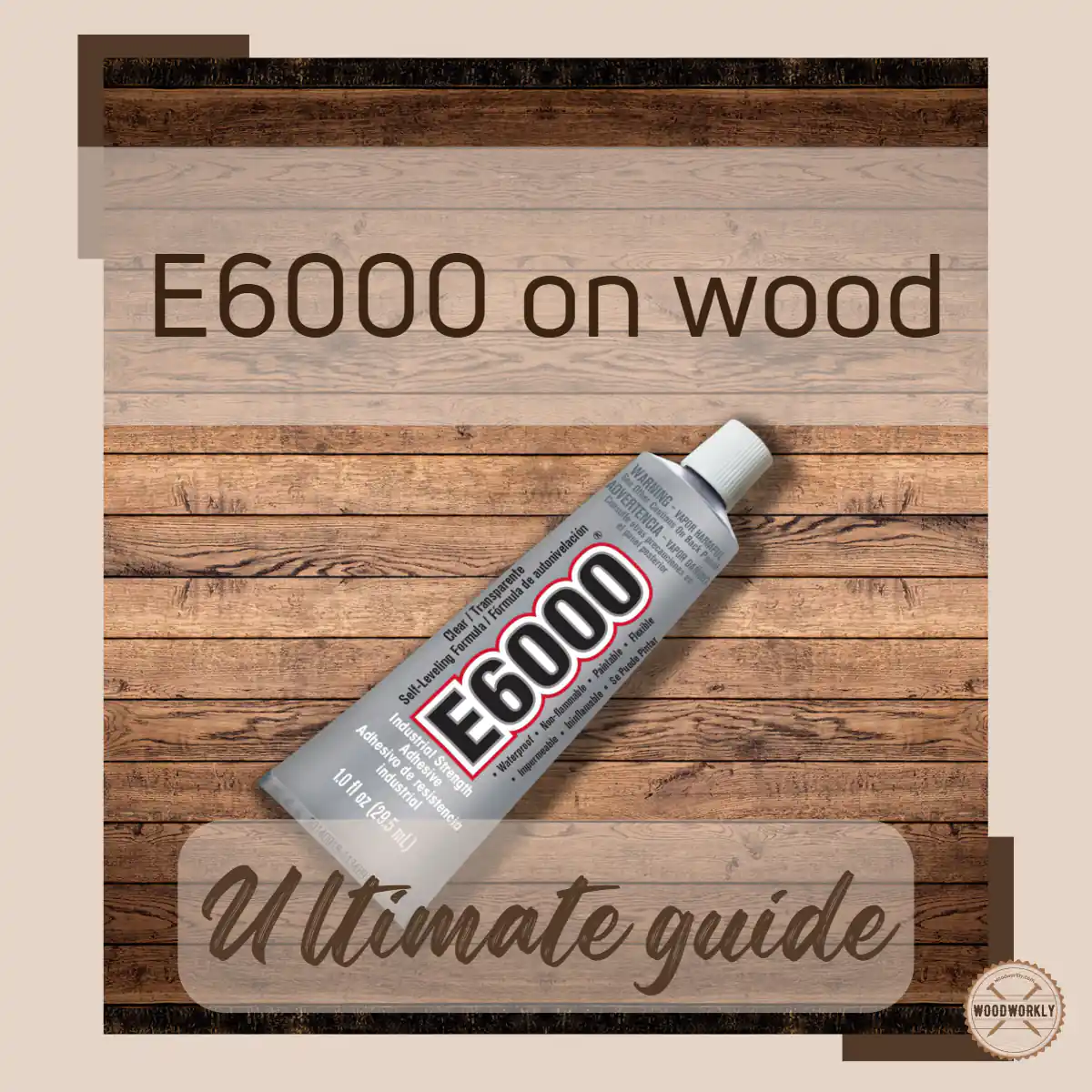
E6000 is a useful adhesive that is widely used as a crafting tool. It has strong adhesion to metal, glass, ceramics, and concrete with excellent industrial performance.
When it comes to woodworking, there’s a trend of using E6000 on woodworking projects as well.
This made me curious and I tried E6000 on several of my woodworking projects and finally, they went really well with all the experience that I’ve gained through the process.
Let me explain, everything I know about, Does E6000 work on wood?
Yes, E6000 works well on wood due to its strong bonding properties. It creates a waterproof, flexible yet sturdy connection between surfaces, making it suitable for both indoor and outdoor wooden applications. It dries clear, ensuring aesthetic appeal isn’t compromised.
But that’s a quick snapshot.

So, in this article, I’ll deeply explore does E6000 work on wood, how strong is E6000 on wood, how to use E6000 on wood, and how to remove it from the wood as well.
Furthermore, I’ll answer some frequently asked questions as well.
So, let’s jump in!
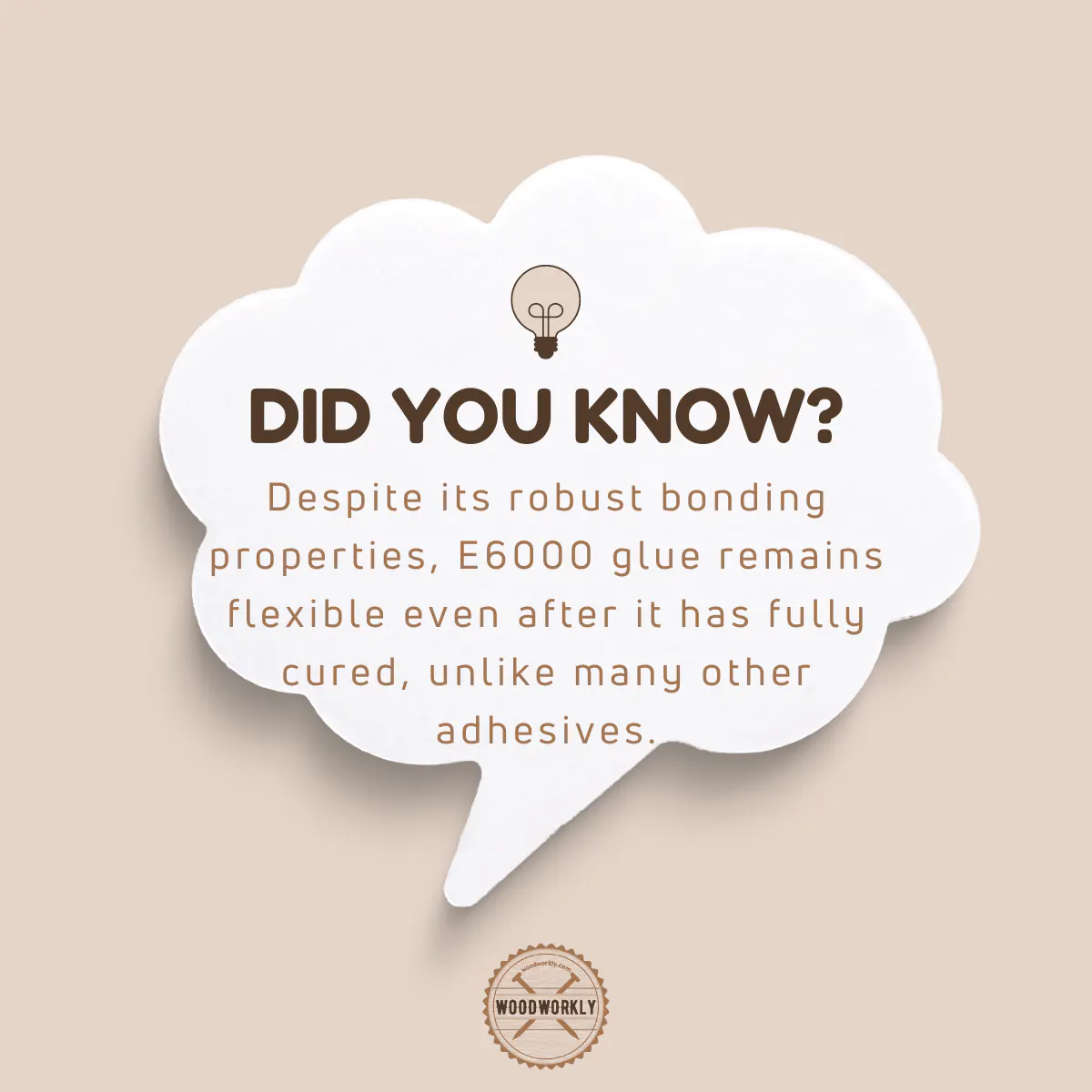
First of all let’s get a quick overview of this cool product: E600
What is E6000 Glue and How Does It Work?
A highly versatile adhesive, E6000 has a flexible hold that doesn’t become brittle under extreme conditions.
It’s known for its exceptional adhesion to wood, metal, glass, fabric, and more. This extraordinary versatility is why it has become the go-to adhesive for many DIY enthusiasts and professionals alike.
The science behind E6000 is quite interesting. At its core, E6000 glue is a one-part epoxy.
This means it doesn’t require any mixing like two-part epoxies.
The primary ingredient in E6000 is a chemical known as tetrachloroethylene. It’s this substance that gives E6000 its excellent bonding properties.
A Personal Encounter with E6000 Glue
Let me share with you a personal anecdote. A while back, I had a favorite ceramic mug that unfortunately took a tumble off the kitchen counter.
As you can imagine, it shattered into several pieces. I was quite disheartened as it was a cherished gift.
However, I remembered reading about E6000 glue and its fantastic bonding properties. So, I decided to give it a shot.
After applying the glue and leaving it to cure for a few hours, I was astonished at the result.
The mug was back to its original form, with no visible cracks or breaks. The adhesive was clear and undetectable.
This experience proved to me the power of E6000 glue!
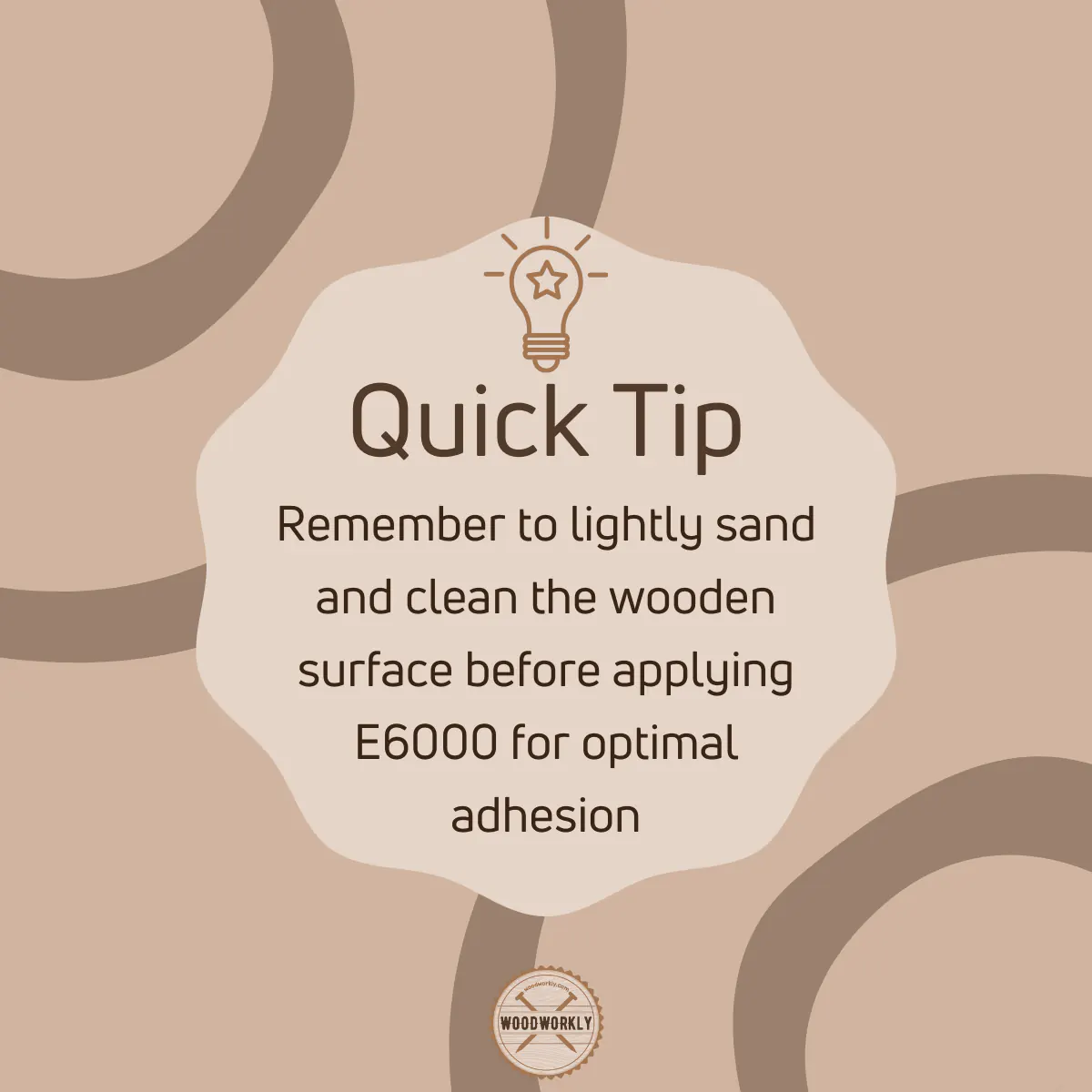
How Does E6000 Glue Works?
Now, let’s explore how E6000 glue works.
After you’ve applied the adhesive to your desired surfaces, the glue needs some time to cure.
This curing process involves the evaporation of the tetrachloroethylene, leaving behind a very sticky substance that creates a strong, durable bond.
E6000 glue is also a self-leveling adhesive. What does this mean?
It simply means that when you apply the glue, it will naturally spread out into a thin, flat layer.
This property ensures even distribution and a strong bond across the entire surface.
Now let’s head into the use of E6000 glue on wood.
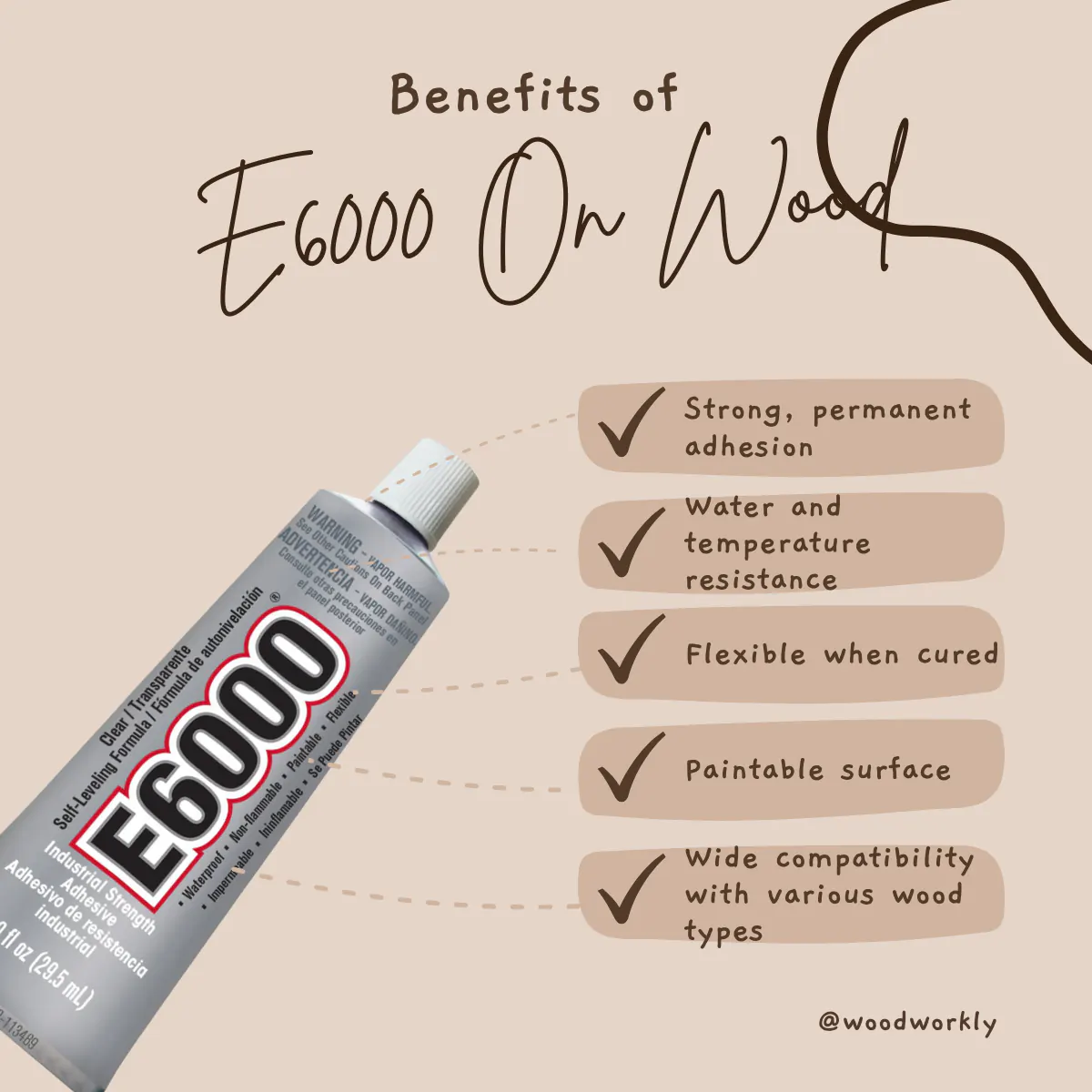
Can You Use E6000 to Glue Wood?
Yes, E6000 is one of the best adhesive glue products you can use to glue wood. It works pretty well with any type of wood.
The bond that E6000 makes with wood is insanely strong, unbreakable, and resistant to many environmental elements such as water, chemicals, and UV light.
Because of having a good resistance against moisture, chemicals, and UV light, E6000 glue can be used for both indoor and outdoor woodworks and furniture.
It gives high dimensional stability to the wood to increase its lifetime.
E6000 is a premium-grade polyurethane adhesive used to bond wood joints and panels, and fill gaps and cracks with tough and robust bonds.
When compared to other wood glue types, E6000 is significantly flexible when it is cured.
As per experts, E6000 is 2X stronger and 60X more flexible than regular polyurethane glue types.
E6000 is easy to use even for a beginner in wood repair. E6000 reacts with food fibers fast and dries within 10 minutes and sets within 24 hours.
Uses of E6000 Glue on Wood
- Filling gaps and cracks
- Assembling wood parts without clamping
- Mending wood parts
- Waterproofing the wood
- Protecting wood from radiation and extreme heat
- Repair and restore woodworks and furniture
Because of having good resistance to impact and abrasion, E6000 can withstand high forces.
Plus, its extreme flexibility prevents the E6000 glue–wood bond from cracking and shrinkage.
It can withstand extremely high and low-temperature levels without breaking.
E6000 is a polyurethane glue. Therefore, it is fire-resistant and able to use near electrical devices.
E6000 is not water-soluble. Therefore, it can be used for bathroom furniture, shelves, and kitchen furniture as well.
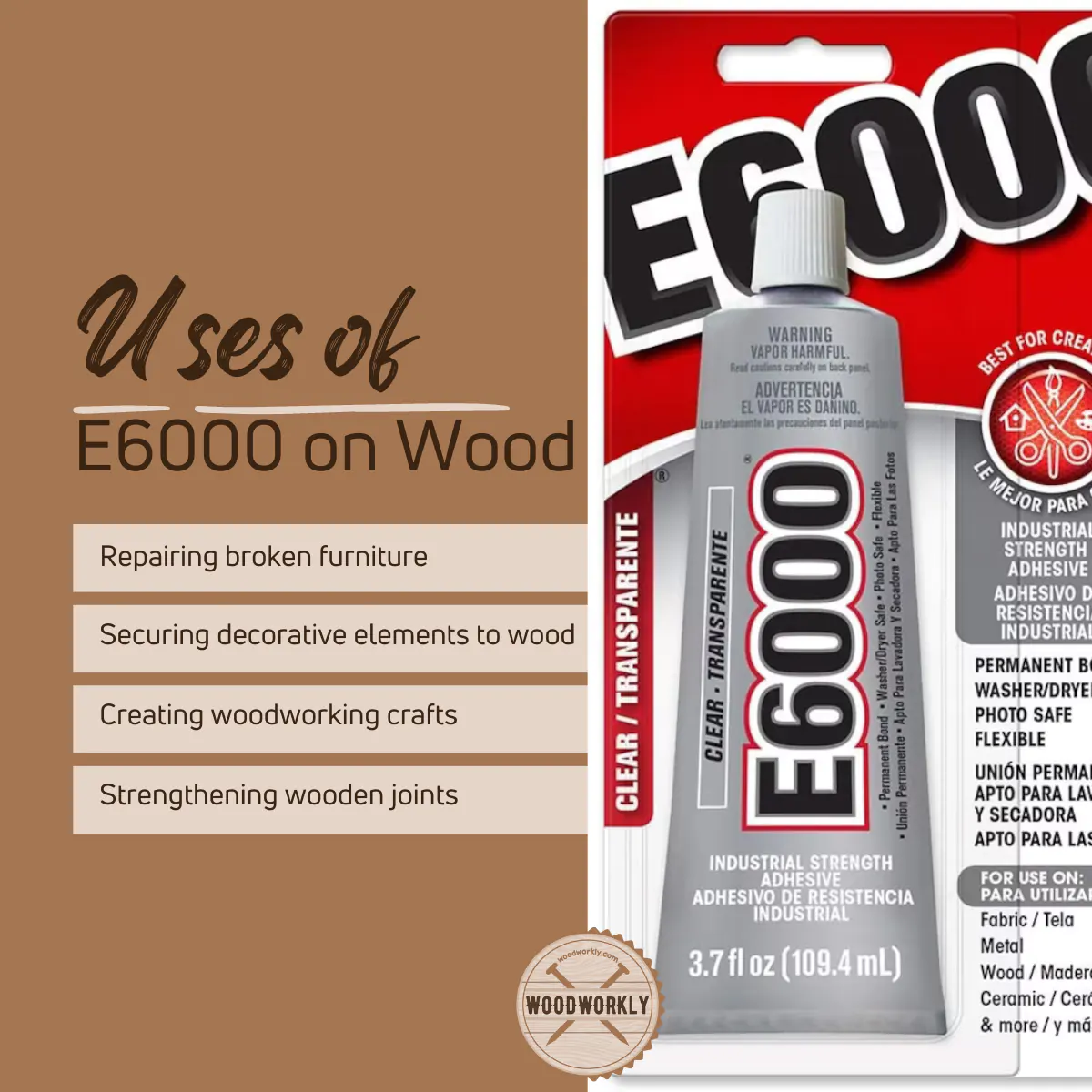
Here’re some advantages and disadvantages of E6000 on wood
Pros and Cons of Using E6000 On Wood
| Pros | Cons |
| Make a strong, unbreakable bond with wood | Harsh odor |
| Waterproof | Hard to remove |
| Not water soluble | |
| Chemical resistant | |
| Temperature resistant | |
| Abrasion and Impact resistant | |
| Dries and cures quickly | |
| Versatile glue | |
| High flexibility | |
| Fire resistant | |
| UV resistant | |
| High tensile strength | |
| Transparent glue | |
| Dries and cures quickly on wood | |
| High durability |
As you can see E6000 is a glue that is filled with lots of advantages.
Cons can be easily skipped using proper wood repairing techniques like applying in a well-ventilated area and following the right method to remove.
Overall, E6000 is so good on wood that you cannot skip it easily.
Does E6000 Work on Painted Wood?
You can apply E6000 on painted wood, but it doesn’t give the strong joint you want. To get a strong joint between wood surfaces, glue needs to be penetrated the wood fibers.
This won’t happen when gluing painted wood because the fiber area is already covered with coats of paint.
Here’s the procedure for applying E6000 on painted wood,
- First, you’ll have to scrape off the paint on the surfaces until the wood surfaces are visible.
- 2. Then apply E6000 on raw wood surfaces.
- Press and hold surfaces for 1 – 2 minutes
- Let it dry and set for about 10 minutes.
- Once it is fully dried apply the same color of paint on top of E6000 glue to make the joint unnoticeable.
Other than following the bale method, better not to apply E6000 on painted woods because it does not hold well on painted surfaces.
Does E6000 Work on Metal to Wood?
Yes, E6000 works well on metal to wood. It makes a waterproof, paintable bond between metal and wood with good resistance against, impact, shocks, vibrations, and extreme temperatures.
If you’re willing to bond and assemble metal parts to your wood furniture, E6000 is one of the best glues you should go with.
It will make unbreakable bonds and highly stable bonds with ease. The application process is also simple without using any clamps.
E6000 is useful in holding steel nails to wood. it bonds with nails within 10 minutes.
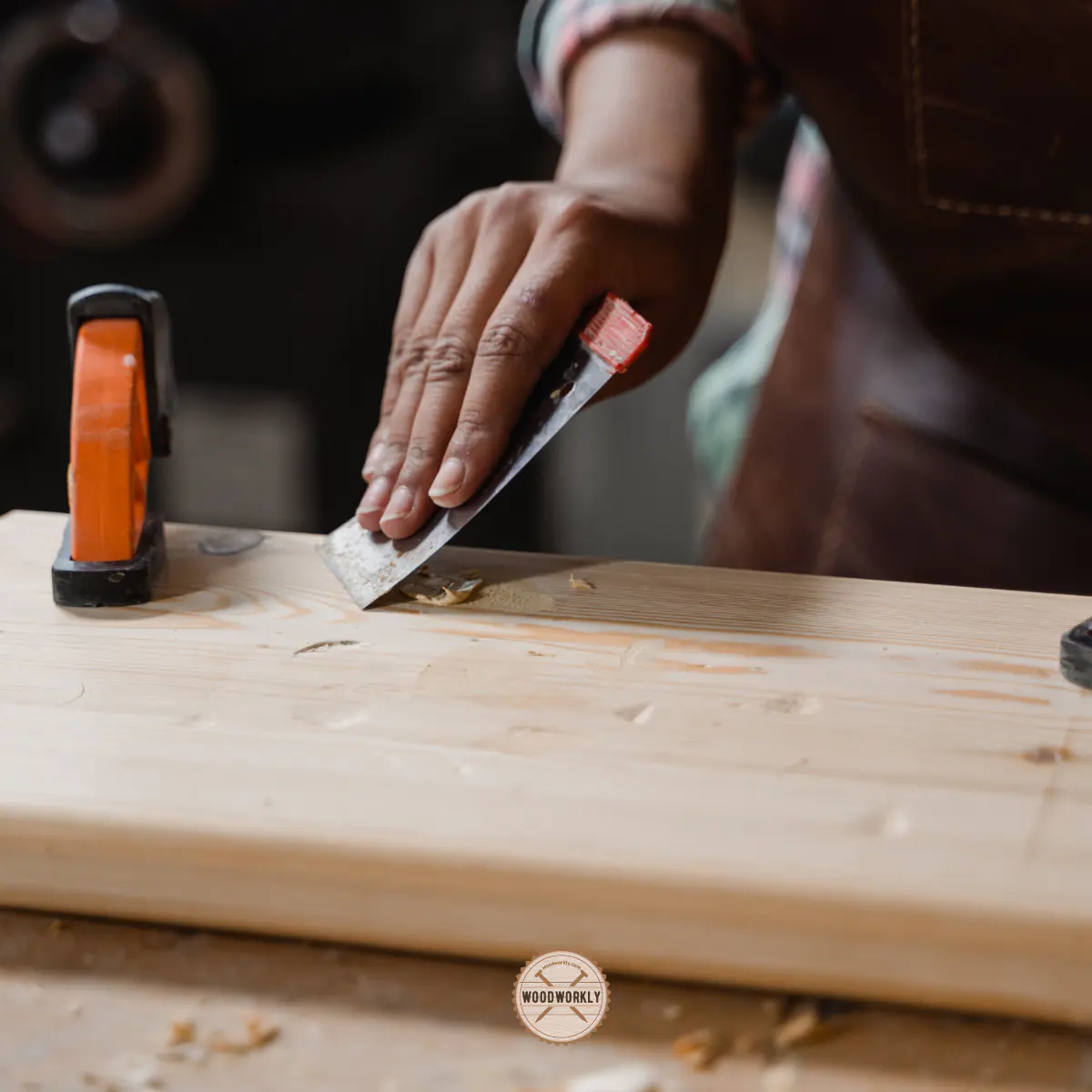
How Strong Is E6000 On Wood?
E6000 is extremely strong on wood with a tensile strength of 3200 psi.
Once cured, it reaches its maximum level of strength by making an unbreakable bond that can withstand impact and abrasion forces.
Once cured, the E6000 bond with wood has a shore hardness of 80. That means it is harder than the hats of construction workers to prevent damage to their heads. That’s super impressive.
E6000 is one of the strongest adhesives that can use for woods in the market.
Once it is cured, E6000 can withstand temperatures from -400F to 1800F. Therefore, it can use under any harsh weather condition without losing its strength.
This is why E6000 is popular for using exterior woodworking projects because it can withstand extreme temperature levels because of being weather resistant. Plus, it is water resistant as well.
E6000 dries within 10 minutes and cures within 24 hours. Apply E6000 sparingly for quick setting and withstand high forces.
Because having excellent strength, E6000 can be used when assembling wood parts, filling gaps, and cracks, and restoring and repairing wood.
Clamping is not required for the adhesion and sets more quickly than many other adhesives.
So, let’s find out how to use E6000 on any wood to get the results we wish.
Supplies You Will Need To Use E6000 Glue On Wood
- E6000 glue
- Woodwork or furniture
- Wood parts or materials
- 220 grit sandpaper
- Damp cloths
Grab the above supplies from a quality manufacturer and get ready for the application process.
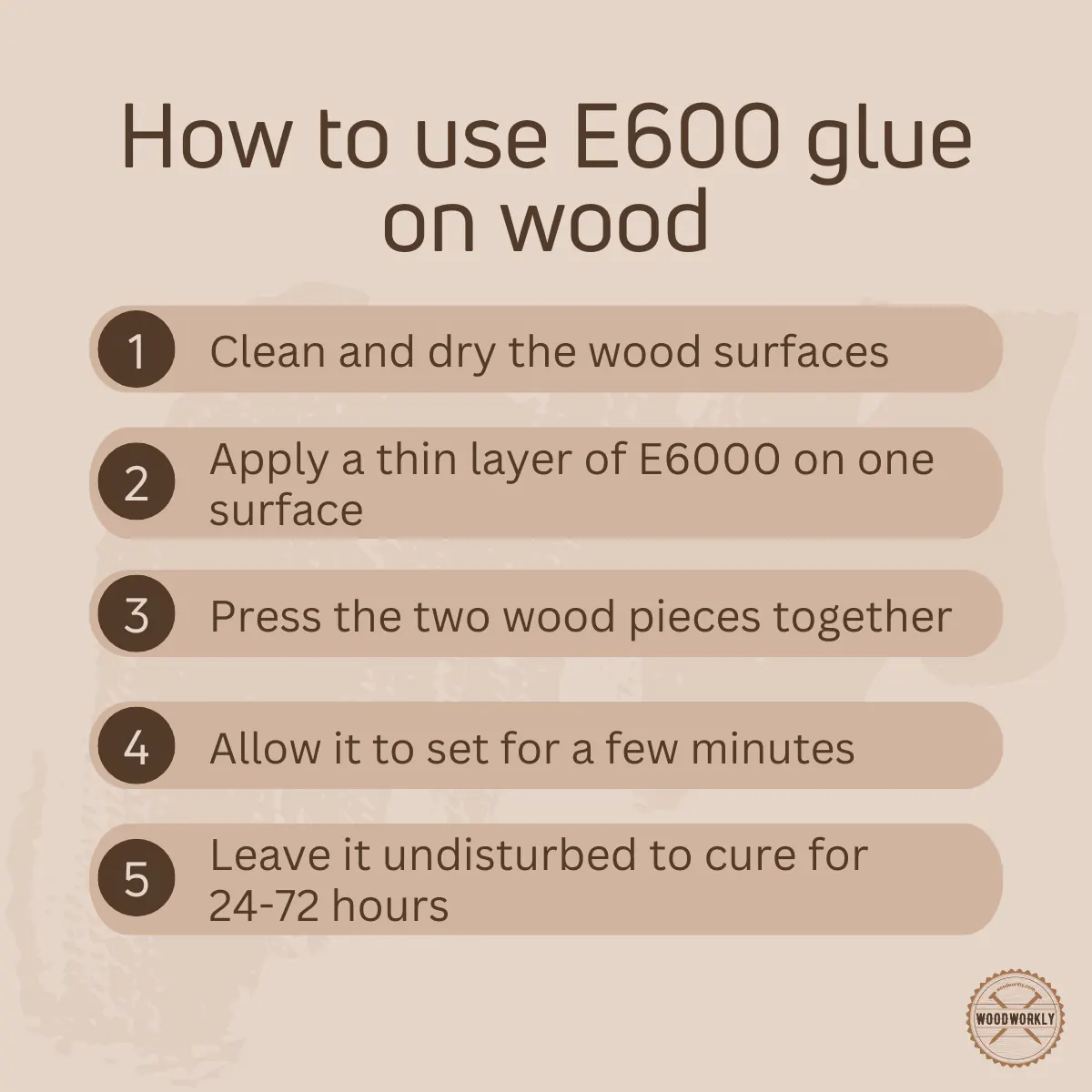
How To Use E6000 Glue On Wood?
E6000 is easy to use on wood. It can be used for any woodwork or furniture to assemble wood parts, and build and repair objects without any issues. E6000 is super user-friendly as well.
Here’s how to use e6000 glue on wood,
- Prepare the area
- Clean the wood
- Sand and remove sawdust
- Apply E6000 glue on wood
- Clean the excess
So, let’s discuss each of the above steps separately to get a better idea of applying E6000 on wood properly.
1. Prepare The Area
Before starting the application process, you need to select a well-ventilated area for the project.
Because E6000 releases bad fumes that can cause breathing problems. Plus, having open air is a plus point for proper better drying and curing.
Wear a mask and take your woodwork or furniture outside or ventilated area like a garage to do the job without causing any problems.
2. Clean The Wood
Cleaning is one of the most essential steps in applying wood glue. Clean the entire surface to remove dust and debris.
Because if dust or dirt gets trapped inside of the E6000, you’re unable to get the maximum bonding strength out of it, and removing is also quite difficult.
Dust, oil residue, grease, and dirt should remove from the surface using a clean dump cloth without missing any spots. E6000 bonds well with clean woods.
3. Sand and Remove Sawdust
After cleaning the wood, sand the gluing surface with 220 grit sandpaper without missing any spots.
Sanding helps to gain a nice and smooth surface which E6000 loves to bond with.
When the surface is smooth without any randomness, wood glue will easily spread and make an unbreakable bond with high adhesion properties.
Never use higher grit sandpapers because they might scratch and ruin the appearance of your woodwork.
Once you’re done with sanding, remove sawdust and other residue using a dump cloth. When the surface is nice, clean, and ready to accept glue, you’re good to move on to the application step.
4. Apply E6000 glue On Wood
Take off the cap of E6000 and puncture the foil inside of the tube. Then, squeeze and take E6000 glue sparingly and apply it on wood surfaces that need to be bonded.
Then hold and press two parts together for 2 – 3 minutes until they’re tightened. Make sure not to make any individual movements during this period to gain a stable bond.
Applying a small amount of E6000 is recommended because when the glue layer is too thick it doesn’t bond well.
Therefore, always apply E6000 sparingly without wasting unnecessary amounts.
After tightening for 2 -3 minutes. leave the joint dry for about 10 minutes. Usually, E6000 bonds dry within 10 minutes.
But this can vary according to the environmental humidity and climate changes. So, better to decide the drying time on your own before making any decisions.
E6000 cures within 24 hours. So, when the bond is completely dry leave it overnight until it completes the curing process before usage.
Once it is fully cured; the maximum strength will be achieved.
E6000 can be used to bond wood with metal, steel, ceramics, glass, fibers, fabrics, and many more. It makes a heavy-duty strong bond without clogs and spills.
E6000 has good water and chemical resistance. It can fill gaps and cracks in the wood without leaving marks.
5. Clean The Excess
After using E6000 glue, recap the tube to preserve the adhesive. Generally, E6000 can be used for about a year once it has been opened for the first time.
Keep it in a clan, dry area to prevent getting tacky.
Remove the excess amounts of E6000 on the surface quickly before they get hardened.
You can use Acetone to remove excess E6000 glue and wipe off the residue from the surface to make it look nice and clean.
After cleaning, proper storing, and curing you’re done with the application job. Now you know how to apply E6000 on wood without making any errors.
Tip:
If you haven’t recapped the tube, it will get tacky and messy. To prevent that apply a little amount of petroleum jelly to the cap nozzle before recapping the tube. It will prevent the glue from getting tacky.
Is E6000 Permanent?
Yes, E6000 glue is designed to create a permanent bond. This adhesive is known for its superior strength and flexibility, which is why it’s often chosen for demanding applications.
I recall using E6000 when I had to fix an old, beloved wooden rocking chair that had been in my family for generations.
The joints were starting to loosen, and I needed an adhesive I could trust to hold up under pressure.
I turned to E6000, and the bond it created has held up superbly, even under the stress of regular use.
E6000: When Permanence Matters
It’s important to remember that the strength and permanence of E6000 make it a fantastic choice when you want a lasting bond, but it can also be a double-edged sword.
Because E6000 is designed to be permanent, it can be very difficult (if not impossible) to remove without causing potential damage.
For example, when I was crafting a mosaic tabletop for my patio, I accidentally dropped a tile in the wrong place.
Once the E6000 had cured, trying to remove the misplaced tile was a real challenge.
I managed it in the end, but not without risking damage to the surrounding tiles. Lesson learned: with E6000, you need to be sure about where you want that bond.
The Role of Preparation and Application
Even though E6000 is meant to be permanent, the bond’s strength and durability also depend on how you prepare and apply the adhesive.
It’s important to ensure the surfaces you’re joining are clean and free of any dust or oil.
I find wiping the surfaces with a bit of rubbing alcohol before applying the adhesive ensures a stronger bond.
The application process is crucial too.
When I was fixing that rocking chair I mentioned earlier, I made sure to apply a thin, even layer of E6000 to both surfaces before joining them.
This helped create a more effective bond.
How To Remove E6000 From Wood?
Once E6000 gets hardened and cured, it is difficult to remove it. E6000 bond is hard to break and you need to be more careful to remove E6000 without damaging the wood surface.
You can remove E6000 from wood using Acetone. Acetone will soften the E6000 and remove it firmly.
Follow the below steps to remove E6000 from wood using Acetone,
- Put some Acetone into a cotton cloth and soak it.
- Apply the cotton cloth to the E6000 glued surface and saturate it.
- Let E6000 dissolve in Acetone for 10 – 20 minutes.
- Rub firmly until E6000 glue gets softened and remove from the surface.
- Repeat the same procedure until E6000 is completely removed.
- Clean the surface with a soft cotton cloth to remove excess and other glue residues.
If you’re unable to find Acetone, nail polish remover, mineral spirits, or vinegar can also do the job well.
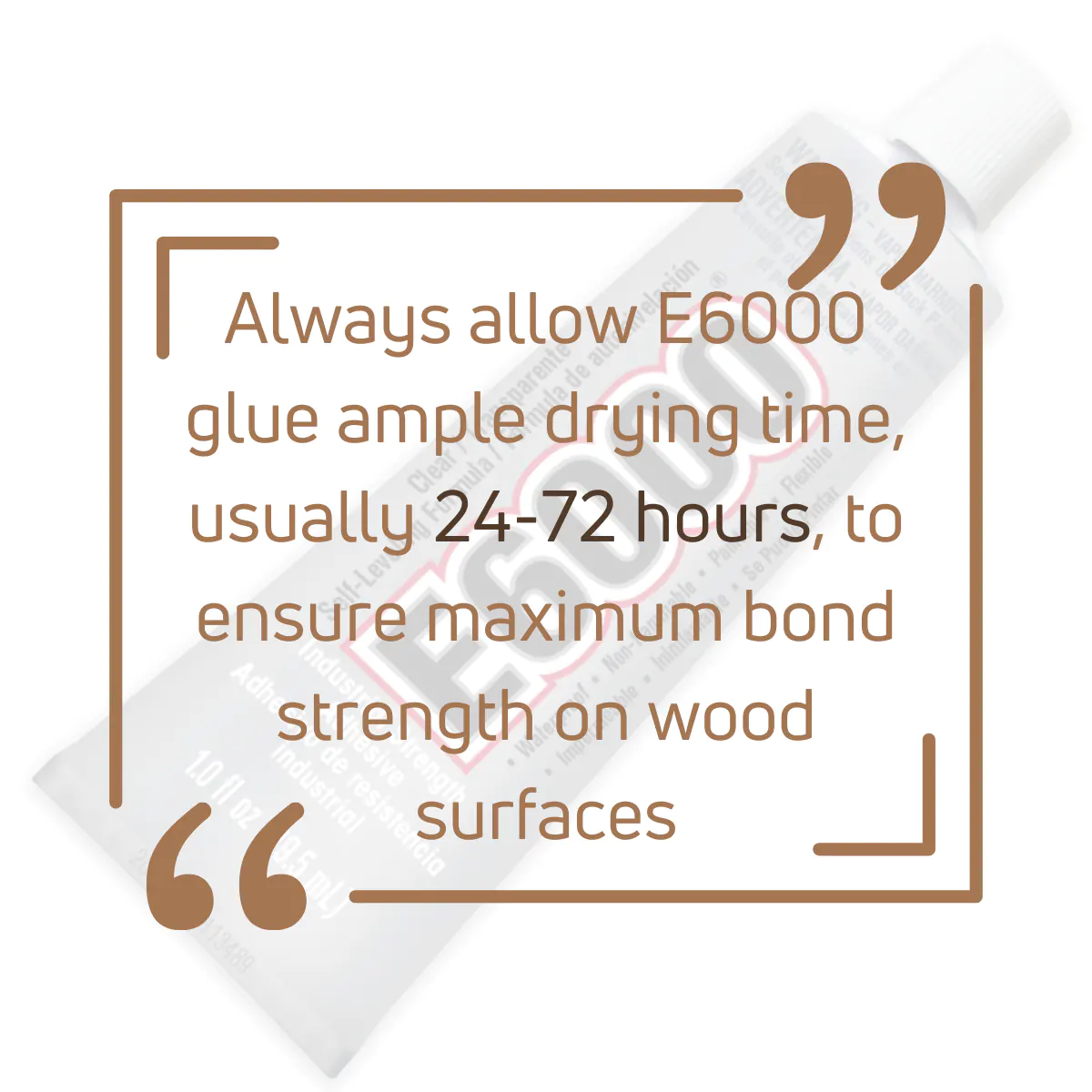
How Long Does E6000 Take to Dry and Cure On Wood?
E6000 dries and hardens on wood in 10 minutes. E6000 takes 24 to 72 hours to complete the curing process. It dries and sets super-fast on wood.
Drying time can differ due to climate changes, environmental humidity, and temperature variations.
But generally, it won’t take more than 20 minutes to dry and more than 72 hours for a cure.
If it takes much longer than that, you have messed up the process, and better to identify the issue and reapply E6000 from the beginning after removing the current by dissolving in Acetone.
Apply a thin layer of E6000 for an efficient job and for quick drying.
Once you apply E6000 on wood, keep it overnight to complete the curing without getting any interruptions.
Once it is fully cured, you’ll be able to get the maximum performance out of it.
For E6000 glue, the drying time is generally quite quick. Depending on the application’s thickness and the environmental conditions, E6000 can dry to the touch within minutes to hours. But remember, ‘dry’ doesn’t necessarily mean ‘fully cured’.
The Curing Process of E6000 on Wood
The curing process is when E6000 truly demonstrates its magic. This is when the glue transforms from being just dry to the touch to becoming a solid, fully bonded adhesive.
On wood, E6000 typically takes between 24 to 72 hours to cure completely.
I’ve had personal experiences with E6000 on wood projects. For instance, I once created a rustic photo frame using reclaimed wood and E6000 glue.
After applying the adhesive, I allowed it to dry overnight. The next morning, the frame was stable and dry to the touch.
However, I waited another two days before adding any weight (like the glass and photo) to ensure the glue had fully cured.
Factors Influencing Drying and Curing Times
You might wonder why there’s a range (24-72 hours) for the curing time.
Well, the exact curing time can depend on a few factors. For example, the humidity and temperature of the environment can affect how quickly the glue cures.
Cooler, drier environments can slow down the curing process, while warmer, more humid conditions can speed it up.
Moreover, the thickness of the glue application can also affect the curing time.
A thin layer might cure in just 24 hours, while a thicker layer may need the full 72 hours.
Overall, while E6000 might feel dry to the touch within minutes to hours, it’s best to allow at least 24-72 hours for the adhesive to fully cure when bonding wood.
This time frame ensures you’ll get the most robust bond possible for your project.
E6000 vs Wood Glue: When to Use Which?
There’s no clear winner in the E6000 vs. wood glue debate. Both are fantastic adhesives in their own right and serve different purposes.
The choice really depends on the specifics of your project and the materials you’re working with.
If you’re dealing with multiple types of materials, E6000 is your go-to adhesive. If it’s an all-wood project, wood glue is generally the best bet.
In essence, the choice between E6000 and wood glue comes down to the specifics of your project.
Are you working exclusively with wood? In that case, wood glue will often give you the best results. Its specialized formulation is designed to work perfectly with the material.
That bookshelf I mentioned? I couldn’t have been happier with the strength and durability of the wood glue bond.
Are you working with multiple materials, including wood? If so, E6000 may be the better choice because of its ability to bond a wide variety of materials.
I still marvel at the versatility of E6000 when I look at my old ceramic and wood lamp.
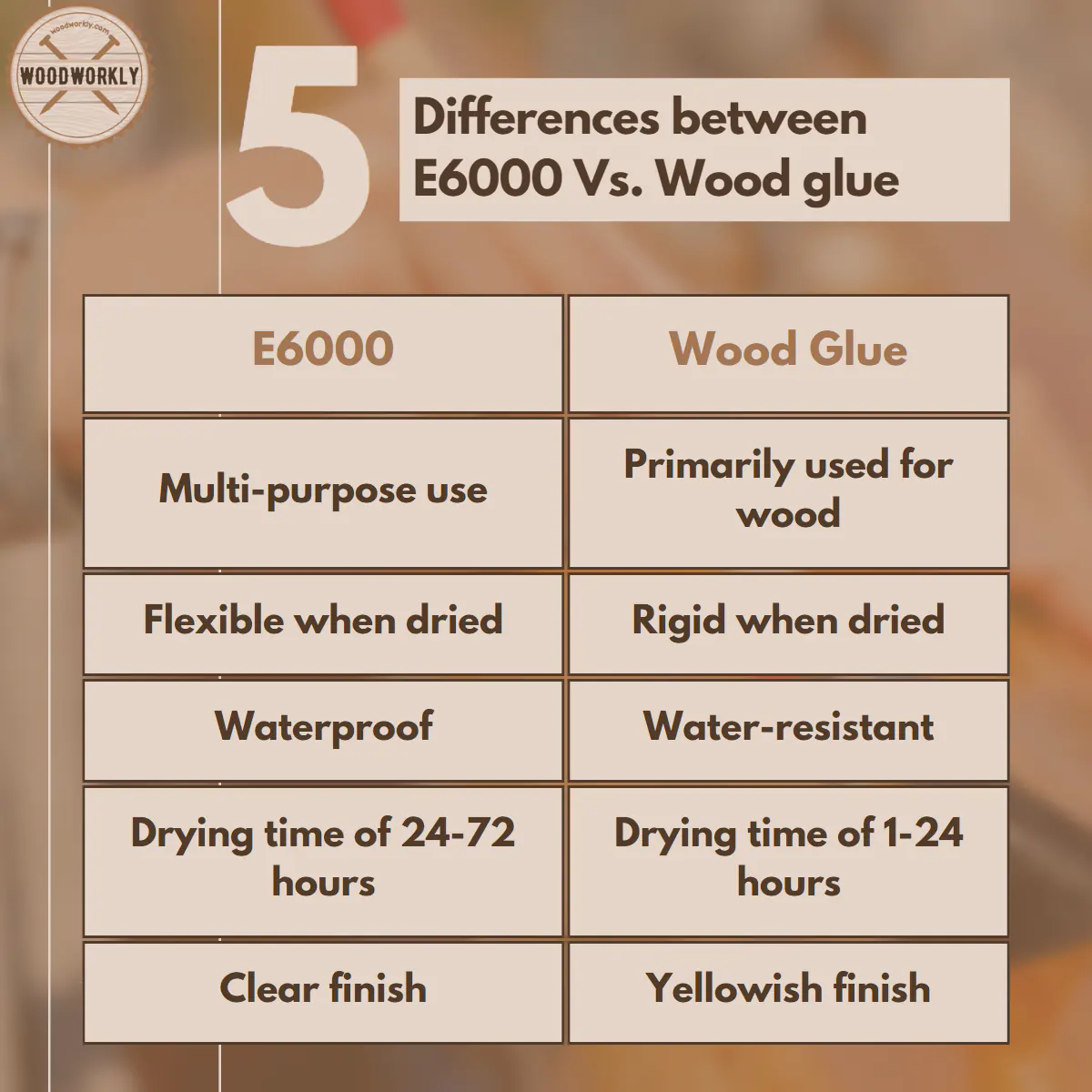
Is E6000 Stronger Than Super Glue?
E6000 is stronger than super glue. E6000 bonds to almost anything. When cured it can withstand temperatures between -40 to 150 Fahrenheit.
E6000 is quick drying and able to make the bond with wood to anything as an industrial adhesive.
Is E6000 Stronger Than Gorilla Glue?
Gorilla glue is a super glue adhesive. Generally, E6000 is stronger than super glue. Therefore, E6000 is stronger than Gorilla glue.
It makes an unbreakable bond with wood that can stick with almost anything including, ceramics, glass, fibers, fabrics, steel, and metal.
It can withstand extreme temperature levels and environmental elements like moisture and UV light. The issue of using E6000 over Gorilla glue is, that E6000 is toxic and causes breaking issues due to harsh chemicals.
Is E6000 Stronger than Hot Glue?
Yes, E6000 is stronger than hot glue. Hot glue can contract and snap off the surface and it doesn’t bond pretty much with anything.
Not like E6000. Because E6000 bonds with anything and it has good temperature resistance than hot glue.
That’s it folks! Now you know everything you need to know about, does E6000 work on wood.
Let’s answer some frequently asked questions.
FAQs
Is E6000 adhesive waterproof on wood?
Yes, E6000 is waterproof. Once it fully cures, the bond remains strong even under water exposure.
Does E6000 glue damage the wood surface?
Generally, E6000 does not damage wood surfaces, but always test on an inconspicuous area first to be certain.
How long does E6000 take to dry on wood?
E6000 typically takes about 24-72 hours to dry fully on wood, depending on the environment and the thickness of the glue layer.
Can E6000 be used for outdoor wood projects?
Yes, E6000 can be used for outdoor projects as it is weather-resistant, making it a good choice for bonding materials that will be exposed to the elements.
Can I paint over E6000 on wood?
Yes, once fully cured, E6000 can be painted over, making it versatile for a variety of craft and repair projects.
Can you use E6000 to hold air plants?
Yes, E6000 can be used to hold air plants. Its strong adhesive properties allow it to securely attach air plants to various surfaces without harming the plant.
Is E6000 food safe?
E6000 is not classified as food safe. While it’s non-toxic once fully cured, it should not come into direct contact with food or be used on surfaces that will be in direct contact with food.
Did I cover all you wanted to know: Does E6000 Work On Wood?
In this article, I have deeply discussed does E6000 work on wood, how to use E6000 on wood, the pros and cons of E6000, and how to remove E6000 from wood as well.
E6000 works well on wood. E6000 has strong adhesion to wood that make an unbreakable, waterproof, and chemical-resistant bond. It makes an ideal bond with wood that is 2X stronger and 60X more flexible than polyurethane. E6000 is useful for indoor and outdoor woodwork. Apply E6000 sparingly on wood for 2 minutes for better adhesion.
Furthermore, I’ve answered some frequently asked questions about how E6000 work on wood as well.
Hope you have gained good knowledge about using E6000 on wood without making any mistakes.
Try to give E6000 a chance in your next wood repair project to see how well it works on wood. Happy woodworking!